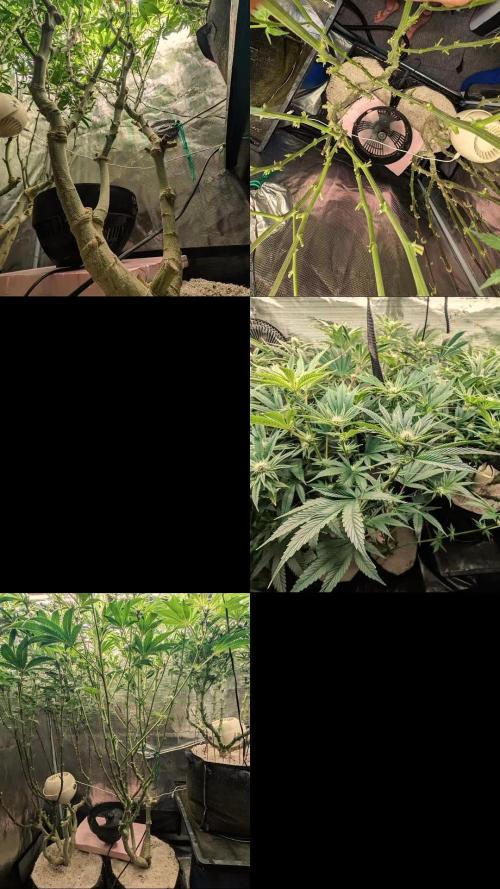The Grow Awards 2026 🏆 





























Likes
234
Share


@yan420
Follow
This two were part of another diary and got moved out due to space reasons at VW8 and moved back indoors at VW20
https://growdiaries.com/diaries/218151-auto-god-s-glue-grow-journal-by-yan402
13.09.25 VW21 Both are looking good and are developing tighter nodes than when they were outside, I'm going to have to keep cutting them back every once and a while I also applied nematodes against thrips and fungus gnats.
20.09.25 VW22 some spots and some yellow leafs, I think it's a root problem, probably root bound, but both seem healthy and are getting thicker so maybe just top up with Coco coir and give a slight different nutrient schedule less Tri Part Bloom could do the trick MAYBE lol.
27.09.25 VW23 Topped up the pots with extra coco coir and trimmed the side roots a bit, both plants were root bound 📹
03.10.25 VW23 did a HST/LST session 📹
12.10.25 VW25 Done a major HST session to try and keep them in line with the Sunset Sherbet GF I have going in the same tent, rest in the video 📹
17.10.25 VW25 ffj/fpj/fish 30 → 60 ml
19.10.25 VW26 it just became a one plant diary, keeping #5, #6 gets it's own diary for testing nutrients.
20.10.25 VW26(?) Feed tweak: added 3 g Calcium Nitrate/ 30 L (≈ 15 ppm N + 10 ppm Ca)
24.10.25 VW26 did a defoliation and trimming session 📹
25.10.25 VW26 I'll be repoting tomorrow, 26.10.25 VW27 rest in the video📹
27.10.25 VW27 Epsom Salt 0 → 2.5, Calcium Nitrate 3 → 9 g
01.11.25 VW28 CalMag 60 → 30ml, TriPartBloom 20 → 30ml, Magnesium 2.5 → 3.5g
04.11.25 VW28 no more yellowing between the veins and no new spots, the changes to the schedule worked, rest in the video 📸
09.11.25 VW29 Did what I'm hoping is a last cleanup 🎥
12.11.25 VW13 Did another cleanup in the tent 🎥, also switched to the FERMAKOR PK Micro schedule, (10.11.25) added Phosphoric acid as a pH down in preparation for flowering
14.11.25 FW1 FERMAKOR PK Micros 40 → 50 ml
22.11.25 FW2 Calcium Nitrate 40 g → 35 g
🌱💦🌱💦🌱💦🌱💦🌱💦🌱
Day to day tasks & actions 🌿
🌱💦🌱💦🌱💦🌱💦🌱💦🌱
22.11.25 FW1 – Fed 5l of #1 → 2l runoff
23.11.25 FW2 – Fed 5l of #1 → 2l runoff
24.11.25 FW2 – Fed 5l of #1 → 2l runoff
25.11.25 FW2 – Fed 5l of #1 → 2l runoff
26.11.25 FW2 – Fed 5l of #1 → 2l runoff
27.11.25 FW2 – Fed 5l of #1 → 2l runoff
28.11.25 FW2 – Fed 5l of #1 → 2l runoff
29.11.25 FW2 – Fed 5l of #1 → 2l runoff
(*RUNOFF reused for indoor house plants)
🍶💧🍶💧🍶💧🍶💧🍶
💧 Nutrients in 30 L #1 Veg — FERMAKOR
🍶💧🍶💧🍶💧🍶💧🍶
💧 Calcium Nitrate (Calcinit / Nitcal):
45 g → 40 g → 35 g
= 1.33 g/L → 207 ppm N + 253 ppm Ca
= 1.17 g/L → 183 ppm N + 224 ppm Ca (current)
💧 PK Concentrate (FERMAKOR Base):
30 ml → 40 ml → 50 ml
= 1.00 → 1.33 → 1.66 ml/L
→ balanced 1:1 P:K + light micros (from extract)
💧 Home-made FFJ/FPJ (Fish + Veg):
30 ml
= 1.00 ml/L
Epsom Salt (MgSO₄·7H₂O):
8 g
= 0.27 g/L → 26 ppm Mg + 35 ppm S
💧 Fetrilon Combi 1 (Micros):
0.5 g
= 0.017 g/L
→ Fe 0.7 ppm • Mn 0.7 ppm • Zn 0.3 ppm • Cu 0.3 ppm • B 0.1 ppm • Mo 0.02 ppm
Phosphoric Acid (pH down) + Citric Acid (chelation):
→ First set pH with phosphoric acid
→ Add a little citric only if extra chelation is needed
💧 Target pH: 5.8 – 6.0 (drop test yellow-green)
📦 TOTAL Inputs:
60 ml → 70 ml → 80 ml / 48.5 g per 30 L
= 2.00 → 2.33 → 2.66 ml/L + 1.62 g/L (current)
⚙️✂️⚙️✂️⚙️✂️⚙️✂️⚙️
✂️ Tools & equipment ✂️
⚙️✂️⚙️✂️⚙️✂️⚙️✂️⚙️
✂️ 2× MarsHydro SP3000
⚙️ MarsHydro 150mm ACF Ventilator
✂️ Trotec dehumidifier (big unit)
⚙️ Mini no-name dehumidifier
✂️ Kebab skewers (LST – stainless)
⚙️ Wire + roast skewers (LST assist)
✂️ Scissors (HST)
⚙️ Vacuum (for spills & cleanup)
✂️⚙️✂️⚙️✂️⚙️⚙️✂️⚙️✂️⚙️✂️⚙️
🍒🍭🍬🌈🍒🍭🍬🌈🍒🍭🍬🌈🍒
🦄Fantasy Feast ( Seeds)🦄
🌈🍒🍭🍬🌈🍒🍭🍬🌈🍒🍭🍬🌈🍒
Species: Hybrid (Regular)
Genetics: The mother is Unicorn Whip by Dirty Bird Genetics. The father is Charcuterie by Cannarado Genetics.
Effect: Unknown Mixed effect body and head high
Flavor: Some phenos are Skunky gassy fruity, some are fruity sour citrus with a chemical touch and a touch of skunk
Flowering: Estimated 8–10 weeks
Resistance: Strong — Testing phase done
YouTube Link: https://youtube.com/-m8h?si=A7x4Zlr2kj-_ga31
Likes
6
Share


@KcKush
Follow
* Increased PPM TO 1050
* I’m getting more fruity, citrus smell now. It’s not overpowering just really light. When it rubs on my hands and clothes the residue is more potent.
* The 2 late flowering plants don’t seem to be progressing look the same to me. Maybe they are more on the photo period pheno with sativa dominance.
Likes
109
Share


@MadeInGermany
Follow
Welcome to the Green House Seeds Company Cup 🏆
Day 20 since the time change to 12/12 h.
Hi everyone 🤗.
Every day she continues to develop her beautiful flowers 😀.
It does not grow any further, but focuses entirely on the full flower production 😍.
About 1 - 1.5 l is poured every 2 days.
The bottom shoots have also been removed so that they don't waste the power in popcorn buds 😊.
The buds are starting to smell better 👍.
I wish you a lot of fun with the diary, stay healthy 🙏🏻 and let it grow 🌱
You can buy this Strain at :
https://greenhouseseeds.nl/
☝️🏼☝️🏼☝️🏼☝️🏼☝️🏼☝️🏼☝️🏼☝️🏼☝️🏼☝️🏼☝️🏼☝️🏼
Green House Seeds Company Cup 🏆
Type:
Wonder Pie
☝️🏼
Genetics:
Wedding Cake x OG Kush
👍😍
Vega lamp: 2 x Todogrow Led
Quantum Board 100 W
💡
Flower Lamp : 2 x Todogrow Led
Cxb 3590 COB 3500 K 205 W
💡💡☝️🏼
Earth: Canna Bio
☝️🏼
Fertilizer: Bio Grow Feeding ( GHSC ) , Enhancer ( GHSC ) , Bio Bloom ( GHSC)
☝️🏼🌱
Water: Osmosis water mixed with normal water (24 hours stale that the chlorine evaporates) to 0.2 EC. Add Cal / Mag to 0.4 Ec Ph with Organic Ph - to 6.0
Likes
2
Share


@ProlificGrowth410
Follow
Having trouble keeping humidity down have to keep the tent cracked open
Likes
16
Share


@nonick123
Follow
Día 15 (27/01) Ha reaccionado bien al trasplante. A ver como se desarrolla en los siguientes días!
Día 16 (28/01) Muestra un buen desarrollo con las primeras ramas formándose
Día 17 (29/01) Subo a DLI 40
Muestra un color verde estupendo 😍
Día 18 (30/01) Tras subir el DLI la temperatura en el indoor ha subido a de 22ºC a 26 ºC, de modo que va a acelerar las necesidades hídricas
Se sigue desarrollando estupendamente 😁
Día 19 (31/01) Seguimos a buen ritmo
Creo que debería haber regado este día... (Visto como estaba de seca al día siguiente...)
Día 20 (01/02) Elimino las ramas más inferiores (1er nudo) que siempre suelen quedar débiles en el stretch
Riego con 350 ml H2O RO
Día 21 (02/02) Empieza a estirarse! 😍
Está sedienta! Riego con 350 ml H2O
En una semana a floración!
FastBuds 15% DISCOUNT code "NONICK" 2fast4buds.com @fast_buds_official_ @fastbuds.official
💦 BioTabs 15% DISCOUNT code "GDBT420" biotabs.nl/en/shop/ @biotabs_official
🌱Substrate PRO-MIX HP BACILLUS + MYCORRHIZAE @promixmitch @promixgrowers_unfiltered
💡2 x Mars Hydro FC1500 EVO Led Grow Light (2024 NEW FC 1500-EVO Samsung LM301H 150W LED) - https://marshydro.eu/products/fc1500-evo-led-grow-lights/ - https://www.amazon.de/dp/B0CSSGN5D8?ref=myi_title_dp
Likes
4
Share


@PacificGrower
Follow
Inicia segunda semana de floración, las plantas se recuperaron muy bien después de la defoliacion que se realizó antes de entrar a floración. Ya se ven los primeros pistilos en las 3 plantas.
Likes
14
Share


@tiasmaaa
Follow
soo little update :
the 2 plants on the right side are probably not Jelly Pie #7 but rather Original Clon from Blimburn... there was a mistake when I got the cuttings. On the other hand the 2 plants on the left, I'm totally sure that they are so strong smelling and so pretty
Likes
12
Share


@FreakShow
Follow
Her roots are boosted amazing and i transplanted her to 7 galon smart pot
And fed her first time 😍😍
Lets see what will happen 🤔🤔
Likes
38
Share


@Aedaone
Follow
These plants got huge. Two of the three were immune to powdery mildew. The third was highly resistant. Saying resistance was strong doesn't do them justice. I included one of the buckets of buds with weight. I had to do that 9 and 10 times depending on plant. Everything went smooth. We missed all the bad weather and got a good dry couple of days to finish harvest. These went a little longer than the 7 weeks. I believe that's because of the suns travel to the south. As it travelled these girls didn't get full sun until after 9:30 a.m. and until 4.20 p.m. They were definitely worth the wait.
Likes
7
Share


@TheGreenHoodlum
Follow
2 phénotypes totalement différents! Une avalanche de trichomes et une odeur de paradis! Cette gorilla cookies est magnifique, vivement la dégustation!!
Le poids humide est approximatif
Qu'en pensez-vous les amis? Des conseils pour la prochaine session?
Peace Love and Let's Grow!
Ps: je vais essayer de poster plus de photos d'ici quelques jours
Likes
6
Share


@Kanbal
Follow
Still doing foliar: Cal-Mag Terra Aquatica, Pro Bloom, and silicate from T.A.
some plants are removed because of root root. naw left with 19/24 plants.
I also use a mobile app to set the light intensity, and I burned the leaves later. Which gave me the knowledge that the application is not very accurate.
Processing
Likes
4
Share


@Grow_of_Leisch
Follow
-Bagseed from Breeder (Friend)-
•Cherry Cream
Genetics:
•Ice Cream Man (mother)
x
•Cherry Wine (CBD) (father)
Ratio 1:1
Processing
Likes
20
Share


@Firsttimegrowercanada
Follow
Day 1 Week 10. Added AN Big Bud to the feeding as per Advanced Nutrients feeding calculator. Still fighting to keep the stretch under control. And the RH is hitting 80% leaving the door partially unzipped. Ordered a small Dehumidifier to help. Changed the cover picture in celebration of an election.
Day 3 week 10. Added a dehumidifier to help bring the RH inline. Sofia and Claudia are starting to show their flowers. Happy girls make happy grower.
Day 5 week 10. Each morning a defoliation, and the next day grown in again. The girls have grown enough to see where they are joined from their single seed.
Likes
22
Share


@eldruida_lamota
Follow
Vamos que os explico un poco critical es una variedad indica con una floración rápida, sus flores son compactas , y bastante resinosas, tiene aromas fuertes.
El ambiente en el secado estuvo en 23 grados de media y 40% de humedad se pasaron rápido al bote de cristal, 7 días en concreto.
Hasta aquí todo familia, espero que os agrade un saludo y buenos humos💨💨💨
Likes
7
Share


@Organic473
Follow
Ants 🐜 Love It! Peter Tosh nah’ lie because these ants won’t leave the girls alone especially when they’re ripping but moving forward I would grow in a greenhouse because I am having other pest problems.


























